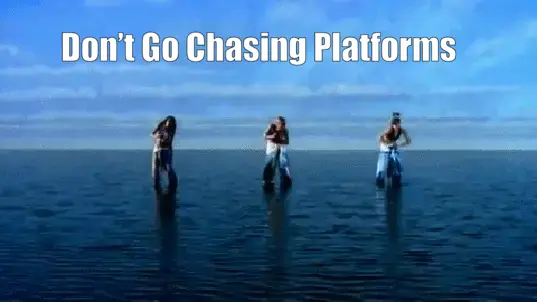🎶 Don’t Go Chasing Platforms 🎶
Most leaders don’t have a technology problem. They have a people and process problem. But solving for that requires facing the mess and that’s where a lot of execs tap out.

You’re not innovating. You’re escaping.
If your instinct is to throw a new tool at an old problem, pause.
Until you clean up the systems and support the people, that platform you’re chasing?
It’s just a shinier way to fail.

Here’s the hard truth:
Most leaders don’t have a technology problem.
They have a people and process problem.
But solving for that requires facing the mess — and that’s where a lot of execs tap out. It’s easier to buy a new solution than to clean up the one you already have. So you chase platforms instead of fixing systems.
It feels like progress.
It looks like strategy.
It’s neither.
A Real Example
I worked with a senior leader who inherited a team that was overwhelmed, reactive, and burned out. Their onboarding process was unclear, their tech stack was a graveyard of half-implemented tools, and no one knew who owned what.
Rather than address those foundational issues, the new leader announced a bold transformation plan. New tools. AI workflows. A full rebuild of their project ecosystem. 🙈
They were excited to make their mark.
But three months in, turnover spiked. Projects stalled. People panicked. And the new platform? Dead in the water.
The problem wasn’t the vision.
It was the refusal to stabilize what was already in place.
🔎 Consider this:
💡 According to a 2023 McKinsey study, 70% of digital transformations fail—largely due to employee resistance, unclear processes, and leadership overreach.
Not the tools.
The context.
You can’t automate clarity.
You can’t outsource accountability.
You can’t lead transformation while bypassing the transformation your team actually needs.
When leaders avoid the hard, human-centered work of readiness, the “solution” becomes just another burden—another promise of efficiency that turns into more confusion, more complexity, more rework.
What Actually Works
Before you launch anything new, ask:
- Do I understand how the current system really works (or doesn’t)?
- Has my team been stabilized and supported through past changes?
- Do we have the capacity—not just desire—for this shift?
And most importantly:
Am I solving for the real problem, or just masking the symptoms?
You don’t build your legacy on the number of tools you implemented.
You build it on what actually worked—because you took the time to do it right.
Chase alignment.
Chase clarity.
Chase readiness.
But please—
🎶 Don’t go chasing platforms. 🎶




